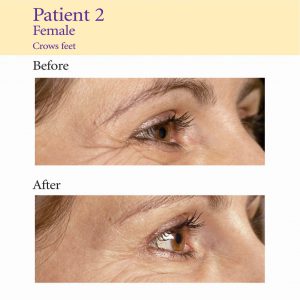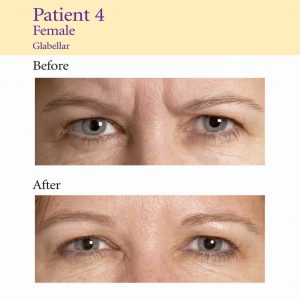Anti-Wrinkle Injections
Anti-Wrinkle Injections
What is Treated
- FOREHEAD (FROWN LINES)
- FROWN-LINES & BROW LIFT
- CROWS FEET
- BUNNY LINES
- GUMMY SMILE
- UPPER LIP WRINKLE
- NASAL FLARE
- NASOLABIAL FOLD & MARIONETTE LINES
- POPPY CHIN
- PLATYSMAL BANDS
- JOWL LINES
- NECKLACE LINES
Quick Facts
- Anti-wrinkle injections help to relax certain muscles in the face that cause wrinkles
- They can be used on frowns, crows feet, and forehead lines
- They can also strategically relax certain muscles to create an eyebrow lift, reduce a gummy smile, slim the jawline, and to stop the downward pull of muscles on the mouth and neck
- They can help to prevent the permanent etching of lines into the face by constant muscle contraction
- They work after 7-14 days and last for 3-4 months
- They are a safe and effective means of reducing wrinkles
- Anti-wrinkle injections can be used to reduce teeth grinding and reduce the size of the masseter (chewing) muscle, as well as help to reduce sweating when injected into the underarms or palms.
- Anti-wrinkle injections can be used in conjunction with dermal fillers to help treat both static and dynamic wrinkles
What are anti-wrinkle injections?
Anti-wrinkle injections, are composed of a natural, purified protein. Due to restrictions the actual name of the anti-wrinkle injection cannot be used here.
When injected into specific facial muscles, wrinkle-causing muscles are relaxed to reduce dynamic lines and create a younger, softer, and natural-looking appearance.
How do anti-wrinkle injections work?
Anti-wrinkle injections treat wrinkles caused by the contraction of facial muscles. They inhibit the transmission of neurotransmitter from the nerve to the muscle and stop the muscle from contracting and forming wrinkles. For example, they can be used to relax the muscles of the frown to prevent the appearance of a vertical frown line, or around the eyes to prevent the appearance of crows feet. It is important to note that anti-wrinkle injections do not immediately improve static lines, or lines that are present at rest. These can be treated by adding volume with dermal fillers or through skin resurfacing. However, usually over a number of anti-wrinkle treatments, the skin that is normally creased has time to rest and recover and an improvement in static lines may be gradually seen. The fact that anti-wrinkle injections also stop the constant compression of skin, prevents the permanent ‘etching’ of wrinkles in the areas treated.
Before and After Gallery
[bscolumns class=”one_half”] [/bscolumns][bscolumns class=”one_half_last_clear”]
[/bscolumns][bscolumns class=”one_half_last_clear”] [/bscolumns][bscolumns class=”clear”][/bscolumns]
[/bscolumns][bscolumns class=”clear”][/bscolumns]
[bscolumns class=”one_half”] [/bscolumns][bscolumns class=”one_half_last_clear”]
[/bscolumns][bscolumns class=”one_half_last_clear”] [/bscolumns][bscolumns class=”clear”][/bscolumns]
[/bscolumns][bscolumns class=”clear”][/bscolumns]
[bscolumns] [/bscolumns]
[/bscolumns]
What are the most common facial areas treated with anti-wrinkle injections?
Anti-wrinkle injections are most commonly used for treatment of frowns, forehead lines, and crows feet. They can also be used to create an eyebrow lift, to stop the mouth from pulling down, reduce gummy smiles (by lowering the upper lip), and to reduce neck bands.
What does treatment involve?
Treatments with anti-wrinkle injections involve having a number of small injections in the treated areas. The process takes only a short time to perform. The needles used are extremely fine, and only a small volume is injected. The discomfort experienced is minimal and well tolerated. You can opt to have anaesthetic cream or ice put on the area prior to treatment to help reduce any discomfort. The effects of anti-wrinkle injections are generally seen only after one to two weeks. You will gradually notice a gradual relaxation of the muscles treated. This can start at 2-3 days, but may take up to two weeks to be very noticeable.
How long do anti-wrinkle injections last?
The duration of effectiveness is dependent on the dose administered and can last up to 4 months, but generally on the first few sessions, the longevity is usually shorter – around 3 months. Studies have shown that anti-wrinkle injections are more effective and last longer when given at regular intervals of 3-4 months due to progressive weakening of the muscles treated. If at any time, you decide to cease treatment, your muscles will return to normal. Wrinkling returns to its previous state, and does not become worse.
Can I resume normal activities after treatment?
Normal activities may be resumed after treatment. However, you will be instructed not to exercise, lie down, or touch the treated areas for 4 hours.
Are anti-wrinkle injections safe?
Anti-wrinkle injections have been used for cosmetic purposes for over a decade and for medical purposes for even longer without any reports of long-term side effects. In Australia, there are six registered indications for the use of anti-wrinkle injections. These are; for children with cerebral palsy in particular body muscles to help reduce spasticity and allow normal movement, to reduce spasms of they eyelid, the treatment of cervical dystonia (neck muscle spasms), treatment of primary hyperhidrosis of the axillae (underarm sweating), treatment of frown lines, and the treatment of focal spasticity in adults.
What are the side effects of anti-wrinkle injections?
Generally, there are few side effects to treatment, and no downtime involved. Occasionally, a bruise may appear over the treated area, and this is more common around the eyes. This can be covered with make-up if applicable. There is usually some transient redness and swelling of the treated area (similar to a mosquito bite), and this usually lasts for less than one hour. Other possible adverse outcomes include ; asymmetrical results, failure to cause a significant change in the wrinkles (usually due to inadequate dosing), puffy eyes (for treatments around the eyes), and a drooping mouth corner (from misplacement of the injections).
When treating the frown with anti-wrinkle injections, approximately one percent of people experience movement of the product into one eyelid and this causes a partial eyelid droop that can last for one month. Any side effect of treatment is temporary and will resolve naturally. A particular eyedrop can be given to temporarily reduce the effect of this side effect if necessary.
What else can be treated with anti-wrinkle injections?
Injected superficially into the skin of the armpits, hands, or feet can reduce excessive sweating in these areas. It requires a starch-iodine test first, which basically highlights the sweaty areas. The area is swabbed with iodine, and then starch is put on top. The sweaty areas become darker. The substance is then injected into these areas after the areas are numbed by anaesthetic cream. It works by reducing the activity of the sweat glands by stopping the nerve transmission to the glands. It tends to last for 8 months approximately. Sweating gradually returns after this time.
Despite local anaesthesia, treatment of the hands and feet can be quite painful, and often a mild anaesthetic gas or intravenous sedation is required to ensure comfortable treatment of these areas. One of the uncommon side effects with treating the hands is mild hand weakness.
Another area that can be treated with anti-wrinkle injections is the masseter muscle, the muscle that is involved in chewing. It is located at the angle of the jawline, near the ears. It is usually treated with anti-wrinkle injections for those people who that they have a square jawline/face and a protruding masseter muscle. Treatment of the masseter muscle with anti-wrinkle injections often helps with bruxism (teeth grinding), and headaches that are caused by this muscle. Usually, at least 25 units of anti-wrinkle injections are required per side to treat this strong muscle.

